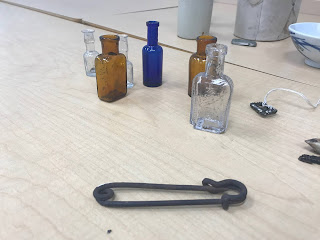The project, which takes place in the Lower Seymour Conservation Reserve (LSCR), in forested areas of North Vancouver Canada, is focused on historic period archaeology between 1900 and 1950. Seventeen students from Capilano University, and the project director Robert (Bob) Muckle will be studying Japanese Canadian and Euro-Canadian sites. Since 2000, Bob has run thirteen other field studies, making this his fourteenth field season. A few Japanese sites have been explored in the area by students in the past, but for 2019 the main focus for excavation and study is the McKenzie Creek Camp. This site was initially used for a few years around 1920 as a Japanese logging camp, and is hypothesized to be used as a secret residential camp hidden in the forest until 1942. In previous years, the McKenzie Creek site was excavated by other field school students who found hundreds of artifacts ranging from bottles to work boots. The site includes many prominent features with evidence of small houses and cabins, a garden, water reservoir, privy and a bathhouse.
We gathered for five hours today at Capilano University to begin our discussions on what is to come in the next seven weeks. The anthropology classroom at the University will be temporarily turned into an archaeology lab for us to have the proper space for our findings and studies. When we all arrived this morning, we did introductions so all students could become familiar with each other before we jump into spending many hours together over the next several weeks. Bob gave us an overview of the project and the history behind it, while also providing us a timeline of the field school. Before taking our lunch break, we were told the type of supplies we would need to carry in our daypacks, such as hand held root clippers, pointing trowels (preferably Marshalltown due to the sturdiness), flagging tape, and most importantly our waterproof notebooks, which were distributed at the end of our classroom session. Throughout the next couple of days we will be learning how to properly fill out our notebooks so archaeologists in the near and distant future will be able to read and understand them. We also accomplished many other exciting things in the classroom today.
We took inventory of our tools and supplies to make sure that we are ready to work in the next few days.
Students taking inventory of the supplies.
Two students counting nails of many sizes.
Bob also showed us some artifacts found by field school students in the past, which gave all of the eager students insight into what we may be discovering ourselves.
 |
| Small bottles possibly used for medicine and a women's shawl pin. |
 |
| Alcohol bottles, lid to an ink bottle, mechanics of an alarm clock, pocket watch and a key. |
After looking at many cool artifacts, Bob made sure to cover the safety procedures for running into wild animals such as cougars or bears, and also gave the group an overview of possible projects for individuals to complete. Once all students have an assigned project, there will be a post or page to outline those on our blog, with updates in our daily posts. We were also shown directions on how to get to the LSCR by car and transit, so hopefully nobody will get lost on the way there in the next few days!
Tomorrow we will be walking through the Lower Seymour Conservation Reserve to look at Euro-Canadian sites, and on Wednesday we will be visiting more historic sites and setting up supplies at the McKenzie Creek camp, so there are many great pictures to come!


No comments:
Post a Comment